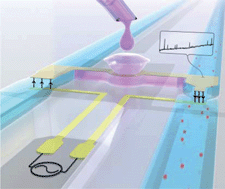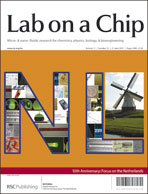A new floating electrode structure for generating homogeneous electrical fields in microfluidic channels†
Abstract
In this article a new parallel electrode structure in a microfluidic channel is described that makes use of a floating electrode to get a homogeneous electrical field. Compared to existing parallel electrode structures, the new structure has an easier production process and there is no need for an electrical connection to both sides of the microfluidic chip. With the new chip design, polystyrene beads suspended in background electrolyte have been detected using electrical impedance measurements. The results of electrical impedance changes caused by beads passing the electrodes are compared with results in a similar planar electrode configuration. It is shown that in the new configuration the coefficient of variation of the impedance changes is lower compared to the planar configuration (0.39 versus 0.56) and less dependent on the position of the beads passage in the channel as a result of the homogeneous electrical field. To our knowledge this is the first time that a floating electrode is used for the realization of a parallel electrode structure. The proposed production method for parallel electrodes in microfluidic channels can easily be applied to other applications.

- This article is part of the themed collection: 10th Anniversary: Focus on The Netherlands

 Please wait while we load your content...
Please wait while we load your content...